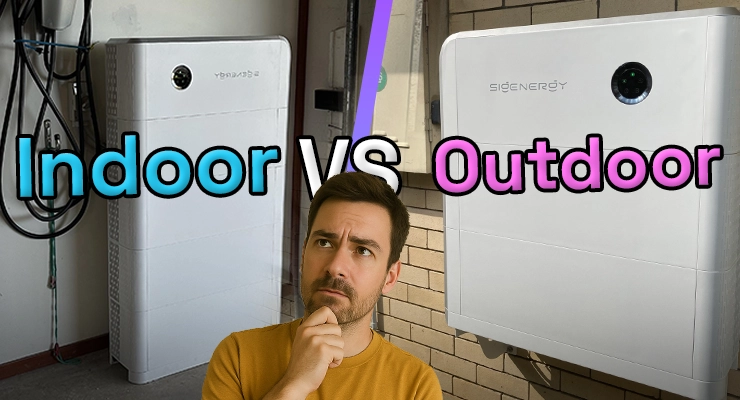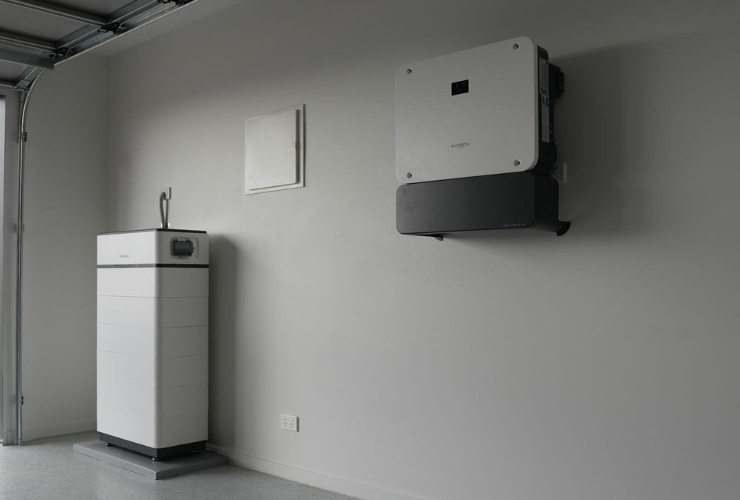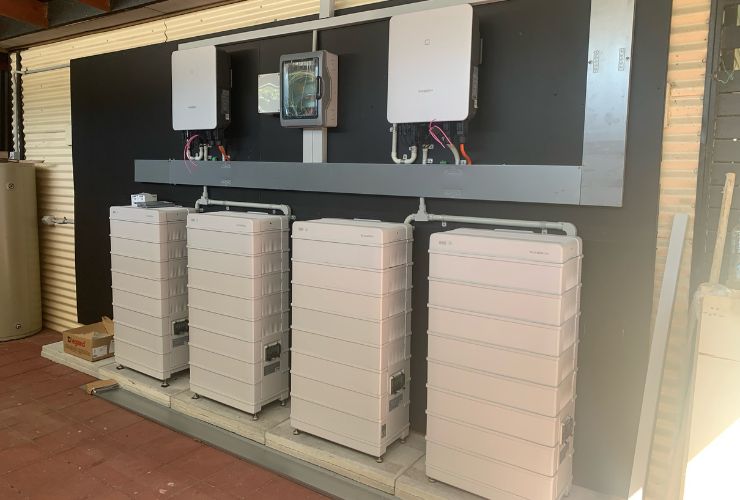Fast read
Choosing where to install your home battery is a critical decision balancing safety, performance, and convenience. Indoor installation, typically in a garage, offers a stable temperature for optimal battery life but is governed by strict safety and space regulations. Outdoor installation saves valuable indoor space but exposes the battery to Australia's harsh climate, which can affect its performance and requires a robust weatherproof design.
What are the pros and cons of indoor vs outdoor battery installation?
Deciding on the perfect spot for your new solar battery isn’t just about what looks best; it’s a crucial decision that directly impacts your system’s safety, lifespan, and financial return. In Australia, this choice is guided by strict national standards, your local climate, and the specific requirements of the battery you’ve chosen.
This article unpacks the pros and cons of installing your battery indoors versus outdoors, helping you have a confident conversation with your accredited installer to find the ideal location for your home.
The case for installing your battery indoors
For many Australian homes, the garage or a dedicated utility room is the default—and often best—location for a battery. It provides a controlled environment that offers several key advantages.
- Pro: Protection from the elements: The biggest benefit of an indoor installation is shielding the battery from extreme temperatures. Lithium Iron Phosphate (LiFePO₄) batteries perform best and last longest within a stable, moderate temperature range, ideally between 20°C and 30°C. A garage protects the unit from scorching summer heat and winter cold, which can reduce performance and accelerate degradation. This stable environment helps maximise your battery’s efficiency and overall lifespan.
- Pro: Potentially simpler installation: Placing the battery indoors near your switchboard and solar inverter can sometimes simplify the wiring process. Shorter cable runs can reduce installation complexity and may slightly lower the overall cost.
- Con: Strict safety and clearance rules: This is the most significant consideration for indoor placements. The Australian Standard AS/NZS 5139:2019 sets out clear, non-negotiable rules for battery installations to ensure safety. Batteries cannot be installed in habitable rooms (like bedrooms, living rooms, or kitchens), ceiling spaces, under stairs, or in escape routes. Specific clearances are required from exits, windows, building ventilation openings, and appliances to prevent any potential smoke from entering living areas. Your installer must adhere to these rules precisely.
- Con: It takes up valuable space: Home batteries are sleek but not small. A typical unit requires dedicated wall or floor space in your garage or laundry, which might otherwise be used for storage or a second fridge. If the battery is installed where a car is parked, Australian Standards mandate that the battery must be protected from accidental impact where damage is reasonably foreseeable. While protective bollards are a common solution, they are not the only method.
The case for installing your battery outdoors
If indoor space is at a premium, an outdoor installation can be an excellent alternative, provided it’s done correctly. Many modern batteries are specifically designed for the challenge.
- Pro: It frees up your indoor space: The most obvious advantage of an outdoor installation is that it doesn’t take up any room inside your home or garage. This can be a major benefit for smaller properties, townhouses, or homes with cluttered garages.
- Pro: Fire safety peace of mind: While battery fires are extremely rare with modern Lithium Iron Phosphate (LiFePO₄) chemistry—the standard for residential systems today—an outdoor location ensures that in the unlikely event of a thermal incident, it is contained outside the home.
- Con: Exposure to Australian climate extremes: This is the primary drawback of outdoor installation. Prolonged exposure to direct sunlight and high ambient heat can cause the battery’s internal management system to reduce its charging or discharging power to protect itself, impacting performance. Over time, this heat exposure can shorten the battery’s operational life. Your installer must choose a location that remains shaded, such as a south-facing wall or under wide eaves, to mitigate this.
- Con: Requires robust weatherproofing: An outdoor battery must be properly protected from rain, dust, and moisture. This is where Ingress Protection (IP) ratings are critical. A truly robust outdoor battery should have a rating of at least IP65, which is certified as dust-tight and protected against low-pressure water jets. For more exposed locations, IP66 offers protection against powerful jets, while IP67-rated systems are even resistant to temporary immersion. Premium all-in-one systems like the Sigenergy SigenStor are built with a high IP66 rating specifically for durable outdoor use.
Key factors that will guide your decision
There is no single “best” answer that fits every home. The right choice is a balance of these factors, assessed by a qualified professional.
- Your local climate: An installation in Hobart faces very different challenges from one in Darwin. The intensity of summer heat and humidity will be a major factor in your installer’s recommendation.
- Available space and home layout: A thorough walk-around of your property will reveal the most practical and compliant locations, whether it’s a spacious garage or a sheltered, non-combustible outdoor wall.
- Your chosen battery system: Different batteries have different requirements. Some systems may be best suited for indoor or very sheltered outdoor locations. Others, like the Tesla Powerwall and Sigenergy SigenStor (IP66), are specifically built to withstand outdoor exposure. The manufacturer’s installation manual is the ultimate guide.
- The wall material: If an outdoor wall is shared with a habitable room and is made of a combustible material like a weatherboard, a non-combustible barrier must be installed behind the battery. The standard requires this barrier to extend 600mm to the sides and 900mm above the battery unit. A brick or concrete wall simplifies this process.
Questions to ask your accredited installer
To ensure you get the best outcome, empower yourself by asking your Solar Accreditation Australia (SAA) accredited installer these questions:
- Based on my home, our climate, and this specific battery, where do you recommend installing it and why?
- What are the specific safety requirements from AS/NZS 5139 that apply to this location?
- If we install it outdoors, how will it be protected from direct sun and rain?
- What is the IP rating of the battery, and is it suitable for this location?
Conclusion: A tailored decision for your home
Ultimately, choosing between an indoor and outdoor battery installation involves weighing the benefits of a stable indoor environment against the space-saving convenience of an outdoor setup. The best location is always a cool, dry, and shaded spot that fully complies with Australian safety standards and the manufacturer’s specifications.
The final decision should always be made in consultation with your accredited installer. Following a transition from the Clean Energy Council that was finalised in May 2024, Solar Accreditation Australia (SAA) is now the approved accreditation body under the federal Clean Energy Regulator. Your SAA-accredited professional has the expertise to assess your property, interpret the complex standards, and recommend a location that ensures your battery operates safely and efficiently for many years to come.





